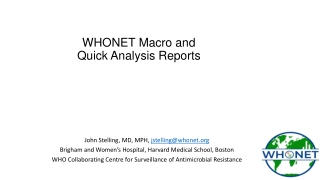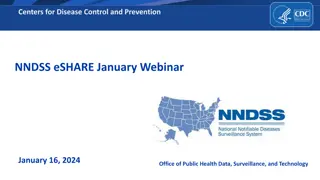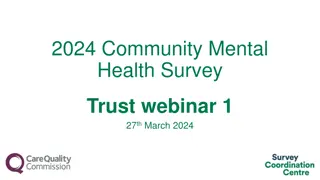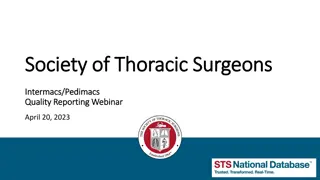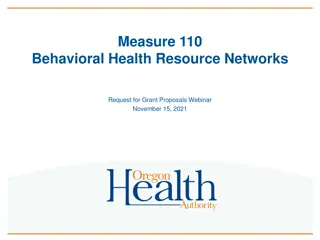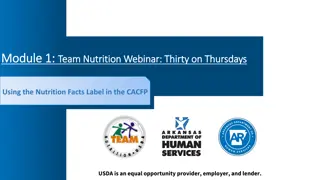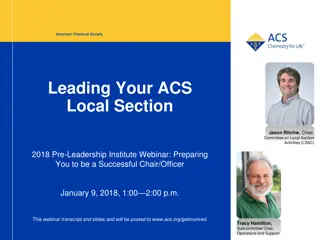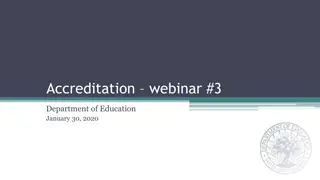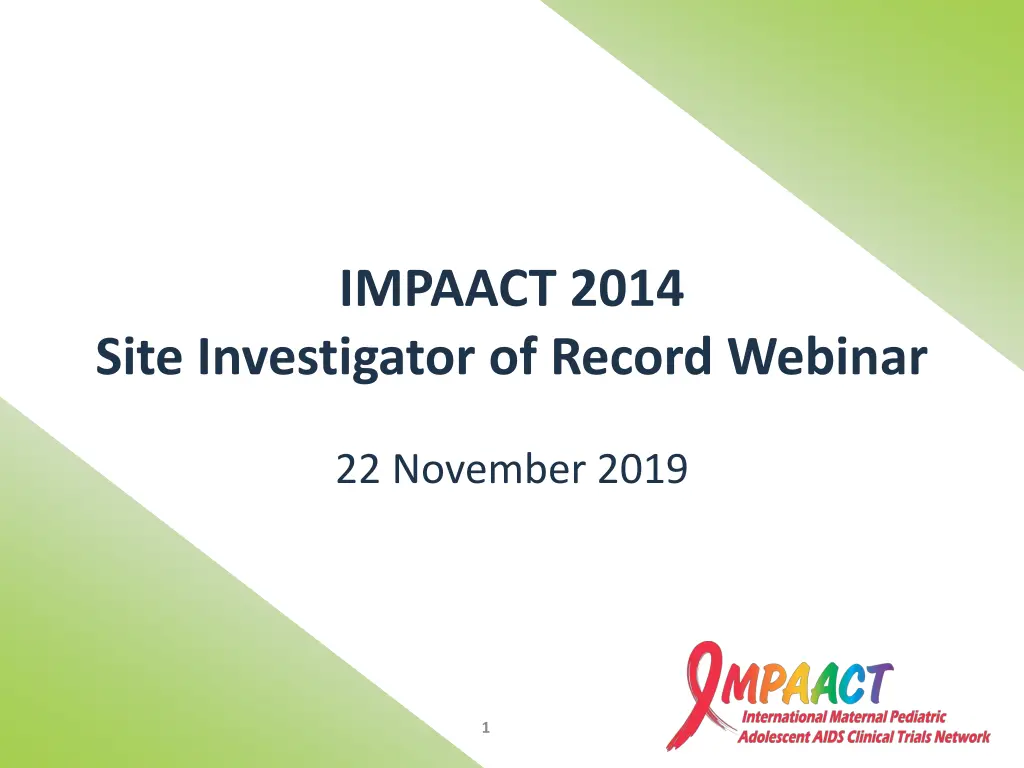
IMPAACT 2014 Study: Doravirine Safety and Pharmacokinetics in Pediatric HIV Patients
Explore the IMPAACT 2014 study focusing on the safety and pharmacokinetics of doravirine in children and adolescents with HIV. Learn about the background, rationale, and the significance of this Phase I/II study for pediatric HIV treatment development.
Download Presentation

Please find below an Image/Link to download the presentation.
The content on the website is provided AS IS for your information and personal use only. It may not be sold, licensed, or shared on other websites without obtaining consent from the author. If you encounter any issues during the download, it is possible that the publisher has removed the file from their server.
You are allowed to download the files provided on this website for personal or commercial use, subject to the condition that they are used lawfully. All files are the property of their respective owners.
The content on the website is provided AS IS for your information and personal use only. It may not be sold, licensed, or shared on other websites without obtaining consent from the author.
E N D
Presentation Transcript
IMPAACT 2014 Site Investigator of Record Webinar 22 November 2019 1
IMPAACT 2014: PHASE I/II STUDY OF THE PHARMACOKINETICS, SAFETY AND TOLERABILITY OF DORAVIRINE (MK-1439) AND DORAVIRINE/ LAMIVUDINE/ TENOFOVIR DISOPROXIL FUMARATE (MK-1439A) IN HIV-1-INFECTED CHILDREN AND ADOLESCENTS Protocol Version 1.0, with Letter of Amendment #1, dated 7 May 2018 Corrected Clarification Memorandum, dated 13 February 2019 Letter of Amendment #2, dated 26 April 2019 2
Background and Rationale Doravine (DOR) is a novel NNRTI with once daily dosing Active against WT and NNRTI-resistant HIV including NNRTI mutations K103N, & Y181C and G190A as well as double mutant K103N + Y181C MK-1439A is an FDC with DOR (100mg) / TDF (300mg) / 3TC (300mg) the TDF and 3TC are new generics 3
Background and Rationale Phase III studies in adults with HIV have demonstrated virologic non-inferiority of DOR + 2 NRTIs when compared with EFV and DRV + 2 NRTIs Significantly fewer neuropsychiatric adverse events in the DOR- vs EFV-treated patients DOR/3TC/TDF demonstrated virologic non- inferiority and safety in adults who switched to DOR/3TC/TDF compared to those continuing a previous suppressive regimen 4
Background and Rationale IMPAACT 2014 is a Phase I/II, multi-site, open-label, non-comparative PK and safety study, the first to evaluate MK-1439 (DOR) and MK-1439A (DOR/TDF/3TC) for labeling in the pediatric population (ages 12 to <18 years old) Will provide PK data to inform the development of DOR and DOR/3TC/TDF in younger children 5
IMPAACT 2014 Opened to accrual March 2018 SMC reviewed data from 9 evaluable Cohort 1 participants in January and February 2019 Recommended continuing to enroll Cohort 1 participants weighing 35-45 kg (targeting 3 additional evaluable participants) while allowing Cohort 2 to open to participants weighing >45 kg with a 100 mg once daily dose of DOR Letter of Amendment #2, dated 26 April 2019, was issued to allow Cohort 2 to open; the Implementation Notice was issued on 16 September 2019 First participant in Cohort 2 enrolled on 22 September 2019 6
IMPAACT 2014: LoA #2 Cohort 1: Up to 20 participants ages 12 to <18 years old to achieve 8 evaluable (with an attempt to enroll approximately 4 evaluable participants between 35 to 45 kg) Virologically suppressed on a combination of DTG or RAL plus two NRTIs Receive single dose DOR and follow-up for 2 weeks Cohort 2: Up to 45 participants ages 12 to <18 years old to achieve 40 evaluable with approved weight in Cohort 1 (with an attempt to enroll approximately 5 participants 35 to 45 kg weight group, if this weight group enrolls and is approved in Cohort 1) ARV na ve and drug susceptible OR virologically suppressed. Receive daily DOR/3TC/TDF and 96 weeks follow-up with primary safety evaluation at 24 weeks 7
Cohort 2 Study Drug Considerations Fixed dose combination DOR/3TC/TDF (MK-1439a) Oral tablet with 100 mg DOR, 300 mg 3TC and 300 mg TDF, film-coated, compressed 35 tablets/bottle Store between 2 C and 25 C (36 -77 F), protected from moisture and freezing Administer orally once daily for 96 weeks May not be crushed or split 8
IMPAACT 2014: Cohort 2
Primary Objective: Cohort 2 Evaluate the 24-week safety and tolerability of DOR/3TC/TDF in HIV-1-infected children and adolescents 10
IMPAACT 2014 Eligibility Criteria For Cohort 2 only
Inclusion Criteria 4.1.1 and 4.1.2 Age 12 years to less than 18 years at entry Weight greater than or equal to 35 kg at entry* Cohort 2 is currently only open to enrollment for participants >45 kg and Cohort 1 is only open to enrollment for participants 35- 45 kg 12
Inclusion Criterion 4.1.4 Confirmed HIV-1-infection based on documented testing of two samples collected at different time points Sample #1 Sample #2 Two different rapid antibody tests One EIA or WB or immunofluorescence or chemiluminescence test One HIV DNA PCR One quantitative HIV RNA PCR (result above LOD) One qualitative HIV RNA PCR One total nucleic acid test Rapid antibody test for a total of three different rapid tests One EIA or WB or immunofluorescence or chemiluminescence test One HIV DNA PCR One quantitative HIV RNA PCR (result above LOD) One qualitative HIV RNA PCR One total nucleic acid test 13
Inclusion Criterion 4.1.5 ART exposure, virologic suppression, and resistance requirements differ for each cohort (and between ART exposure history in Cohort 2) Some requirements may be fulfilled based on individual or parent/guardian s report Some requirements must be confirmed by medical records Some requirements must be confirmed by active laboratory testing during screening 14
Inclusion Criterion 4.1.5.2, Cohort 2: ART-na ve At entry, received no ARVs for treatment of HIV infection including investigational agents (prior receipt of ARVs for prevention of perinatal transmission is permitted) AND Screening genotypic resistance test results indicate susceptibility to DOR, TDF, and 3TC (result must be available prior to enrollment) Note: For individuals that are re-screened, the genotypic resistance test does not need to be repeated. AND If available, any prior genotypic resistance test result indicates susceptibility to DOR, TDF, and 3TC Individual or parent/guardian s report and, if available, confirmed by medical records Performed during Screening As documented in medical records 15
Inclusion Criterion 4.1.5.3, Cohort 2: ART-experienced No previous history of change in ARVs due to clinical or virologic failure, in the opinion of the site IoR/designee AND Virologic suppression, as defined by: One or more HIV RNA PCR result below level of quantification within 15 months prior to enrollment, AND If any HIV RNA PCR tests have been done within 3 months prior to enrollment, all results are BLLQ, AND HIV RNA PCR result less than 40 copies/mL at screening AND If available, any prior genotypic resistance test result indicates susceptibility to DOR, TDF, and 3TC Individual or parent/guardian s report and, if available, confirmed by medical records As documented in medical records As documented in medical records Performed during Screening As documented in medical records 16
Inclusion Criteria 4.1.6, 4.1.7, and 4.1.8 Grade 2 or lower hemoglobin, AST, ALT, alkaline phosphatase, and lipase on specimens obtained at screening Grade 2 or lower creatinine, proteinuria, and glycosuria on specimens obtained at screening Estimated glomerular filtration rate (eGFR) 60 mL/min/1.73 m2, on specimens obtained at screening, based on the Schwartz equation 17
Inclusion Criteria 4.1.9, 4.1.10, 4.1.11 For females who have reached menarche or who are engaging in sexual activity (self-reported), negative pregnancy test at entry For females engaging in sexual activity that could lead to pregnancy (self-reported), agrees to use two effective, medically accepted birth control methods while on study and for two weeks after permanently discontinuing study drug For males engaging in sexual activity that could lead to pregnancy (self-reported), agrees to use condoms while on study and for two weeks after permanently discontinuing study drug Performed during Entry Discuss at Screening and Entry Discuss at Screening and Entry 18
Inclusion Criteria 4.1.12 Able and willing to swallow available formulation(s) (tablet or, as available, oral granules) Discuss at Screening and Entry The oral granule formulation is not currently available for use with Cohort 2 participants. Upon initiation of screening, all potential Cohort 2 participants should be counseled that only the tablet formulation is available at this time. 19
Exclusion Criterion 4.2.1 Evidence of decompensated liver disease manifested by the presence of or a history of ascites, esophageal or gastric variceal bleeding, hepatic encephalopathy, or other signs or symptoms of advanced liver diseases NOTE: Individuals with chronic hepatitis B who have grade 2 or lower ALT and AST and have no significant impairment of hepatic synthetic function (significant impairment of hepatic synthetic function is defined as a serum albumin <2.8 mg/dL or an INR >1.7 in the absence of another explanation for the abnormal laboratory value) are eligible. 21
Exclusion Criterion 4.2.2 Detectable hepatitis C virus (HCV) by RNA PCR or current or planned treatment with direct antiviral agent for HCV NOTE: HCV antibody positivity but undetectable by HCV RNA PCR results are permitted. 22
Exclusion Criteria 4.2.3-4.2.6 Presence of any active AIDS-defining opportunistic infection History of malignancy (ever), with the exception of localized malignancies such as squamous cell or basal cell carcinoma of the skin Clinical evidence of pancreatitis, as determined by the clinician (at entry) Use of nafcillin, dicloxacillin, or any of the prohibited medications, within 30 days prior to study entry (see Section 5.8 for a complete list of prohibited medications) 23
What are your questions about the IMPAACT 2014 study design and eligibility criteria? 24
Key Reminders Related to Study Evaluations in Cohort 2
Section 6: Example of Procedure Table 27
Section 6: Example of Procedural Text 28
Cohort 2 Screening Reminders For ART-na ve participants the screening period should be as short as possible so that ART is not delayed Screening is discontinued when ineligibility is determined Screening procedures may be repeated, with the latest outcome used for eligibility determination Participants may be re-screened once in a six- month period 29
Screening Visit Reminders Perform evaluations and procedures as included in protocol Section 6.1: For ART na ve participants only, genotypic resistance testing results must be available prior to Entry, per Criterion 4.1.5.2 As soon as the creatinine result is obtained, the estimated GFR should be calculated using the Schwartz formula, graded for severity, and assessed for clinical significance concurrent with all other laboratory test results HIV-1 RNA assays must be performed in real time in a CLIA- certified (US sites) or VQA-approved (non-US sites) laboratory using the Abbott RealTime Viral Load Assay 30
Complete Physical Exam Height & weight Vital signs Heart rate Temperature Blood pressure Examination of other body systems driven by other identified signs or symptoms Examination of General appearance Head, eyes, ears, nose, neck, mouth and throat Lymph nodes Lungs, heart, and abdomen Musculoskeletal system Skin Neuro Sexual Maturity Rating (SMR) (Entry only) additional assessments may be performed at the discretion of the examining clinician 31
Cohort 2 Entry Visits Key operational reminders Final eligibility determination and confirmation (medical history, complete physical exam, and, if needed, pregnancy testing) must precede enrollment Enrollment must precede prescribing of study drug Pre-dose PK blood sample must precede ingestion of the first dose of study drug ART experienced, virologically suppressed participants will discontinue previous ARTs and start DOR/3TC/TDF on the day of enrollment If the granule formulation becomes available, selection and confirmation of formulation must precede enrollment. 32
Pre-dose sparse PK blood sample must precede ingestion of the first dose of study drug. When should you not collect this sample? A. With the blood for pregnancy testing B. With the blood for CBC, chemistries, CD4 cell counts, and HIV-1 RNA C. We would not collect the PK sample with other samples D. Something else 33
Pre-dose sparse PK blood sample must precede ingestion of the first dose of study drug. When should you not collect this sample? A. With the blood for pregnancy testing B. With the blood for CBC, chemistries, CD4 cell counts, and HIV-1 RNA C. We would not collect the PK sample with other samples D. Something else 34
Cohort 2 Week 1 First 10 participants enrolled in Cohort 2 Cohort 2 intensive PK samples will be batch shipped and will generally be run after all intensive PK samples have been collected. As noted in the LPC, samples should be stored on site and batch shipped upon team request. 35
Cohort 2 Week 1 First 10 participants enrolled in Cohort 2 Cohort 2 intensive PK samples will be batch shipped and will generally be run after all intensive PK samples have been collected. As noted in the LPC, samples should be stored on site and batch shipped upon team request. 36
Key Reminders on Expedited Adverse Events Reporting The following types of adverse events must be reported in an expedited manner in IMPAACT 2014: Serious adverse events (SAEs) All Grade 4 adverse events All pregnancy complications, including intrauterine fetal demise, spontaneous abortions, or therapeutic or otherwise medically indicated abortions All malignancies Any immune reconstitution inflammatory syndrome (IRIS) events 37
Key Reminders on Expedited Adverse Events Reporting For each enrolled participant: Begins: At the time of administering the first dose of study drug Ends: Through the protocol-specified end of follow-up (for Cohort 2, through Week 96) 38
Key Reminders on Study Monitoring and Participant Management General management guidelines provided in protocol Table 18 Protocol Section 8.3 provides specific guidance related to liver toxicities Protocol Section 8.4 provides specific guidance related to decline in renal function Any interruption of DOR/3TC/TDF of more than seven days should be discussed with the CMC prior to restarting. 39


